From Crinoids to Concrete: Sundew Collections Serves as a Window into the Geologic Past
At the North Cascades Environmental Learning Center, we have an impressive natural history collection on display in our Sundew building. Named after a carnivorous plant that looks like a monster’s toothy mouth, Sundew serves as place for staff, students, and guests to explore the North Cascades Ecosystem through tangible specimens and displays. This year, graduate student Gina Roberti, is acting as the Natural History Collections Assistant for her Work Study position. Her job is to maintain the Learning Center’s Natural History Collection, and to create relevant displays and provide access to collections / trainings for the education team. So far, she has done a wonderful job promoting this valuable resource, and has brought her passion for rocks and geology to the position as well.
Now, in her own words, here is what Gina finds most exciting about the Sundew Collections:
Come explore the Sundew Collections at the Environmental Learning Center to catch a glimpse of life 330 million years ago! Our collections contain an impressive breadth of rock samples formed in a variety of environments representative of the geologic diversity of the North Cascades. This region hosts rocks that were once ancient seafloors, volcanic islands, swampy marshes and underground magma chambers. Here, they have been juxtaposed together, sliced apart, intruded by more magma, and translated hundreds, sometimes thousands, of miles along faults in the Earth’s crust. Many of these rocks are also metamorphosed (or “cooked”) under extreme pressures and temperatures, providing evidence for changes in plate tectonic motions in this region in the past. The Sundew Geology Collection provides a window into understanding how this part of North America has changed over time.

Chilliwack Limestone Crinoid Fossils in Sundew Collections
My goal today is to highlight a heavy block of rust-colored rock known as limestone, pictured above. A closer look at this rock reveals tens of tiny screw-shaped features. These are the fossilized remains of ancient ocean organisms called crinoids! Crinoids are commonly called “sea-lilies,” though they are animals, not plants. The most commonly preserved part of a crinoid is its stem. See below a picture of how large crinoids can grow. This fossil along the San Juan River in southeastern Utah was measured approximately five feet long!
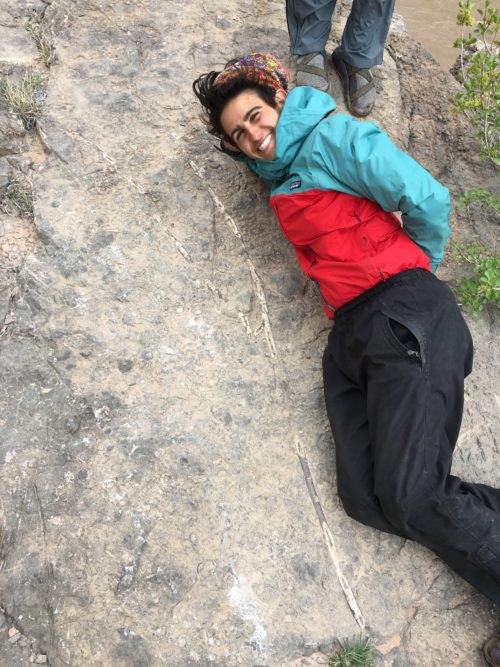
Graduate M.Ed. candidate Gina Roberti poses by a large crinoid stem outcropping in the Hermosa Formation limestones, accessible by white water rafting in the upper San Juan River canyon (formerly part of Bears Ears National Monument).
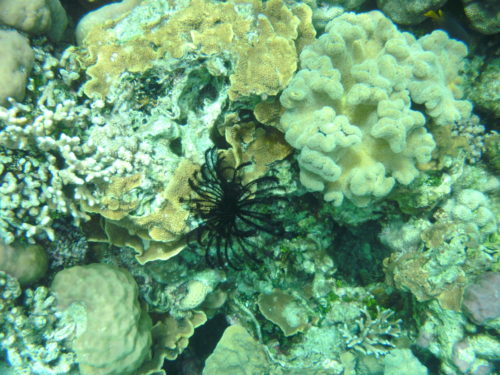
Crinoids are part of the animal kingdom: as echinoderms they are related to starfish, sea urchins and sea cucumbers. Crinoids are still alive today; see this picture taken by NCI graduate student Charlee Corra when scuba diving in Wakatobi, Indonesia in 2011.
The limestone in our collection is part of the Chilliwack River Terrane. These rocks are especially important in the Skagit valley for their use in making cement! The outcrop of Chilliwack limestone by the Baker Dam is one of the largest exposures in the region, which gave rise to the town of Concrete in 1909. Have you ever visited Concrete and seen the huge cement silos? This outcrop provided the majority of concrete used in constructing the area’s hydroelectric dams, including Ross, Diablo and Gorge Dams. It also provided much of the concrete used to build to urban infrastructure in Seattle for the first half of the 20th century. However, after the boom came an economic bust, and the Concrete mill closed in 1968.
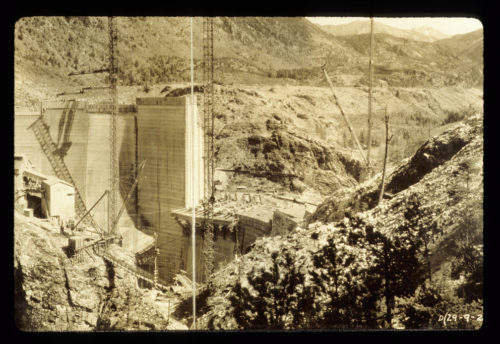
Photograph of the construction of Diablo Dam (circa 1927), one of three hydroelectric dams that comprise the Skagit River Hydroelectric Project owned and operated by Seattle City Lity. At the time of its completion, Diablo Dam was the tallest dam in the world at 389 feet high
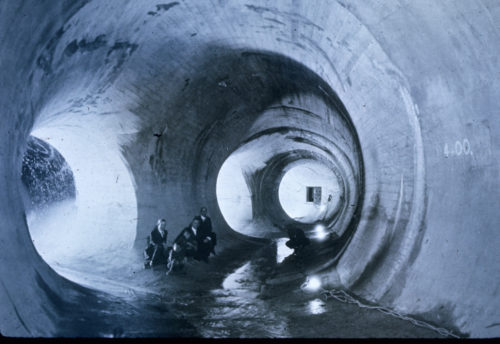
A family poses inside the concrete intake tunnel at Gorge Dam, which diverts water to the powerhouse downstream through an 11,000 foot long tunnel. Gorge Dam is the first of the three dams built on the upper Skagit River, and was rebuilt in 1961. For more information on the Skagit River Hydroelectric Project, click here.
To me, the beauty of looking into the past is discovering how it can change our views of the present. By exploring the geologic story contained in one small piece of rock, we uncover connections about ourselves and our community. Attached is a final image from one of my favorite geologists, Dr. Ron Blakey from Northern Arizona University. As a paleogeographer, Dr. Blakey creates maps of the world in the past (“paleo”+ “geography”). His maps are incredibly detailed, and take many years to compile. Each map is painted by hand and draws on a multitude of information from the geologic past. Sedimentary rocks provide evidence about the direction, size and flow of ancients rivers, the location of deltas and shorelines and global sea levels. Predictions of global climate are used to determine where there are forests, deserts, or ice. Inferences about plate tectonic motions in the past are used to infer the location of past mountain ranges, valleys and lakes. All of this evidence helps paint the ‘colors’ of the Earth’s surface and shape of each continent in Dr. Blakey’s work.
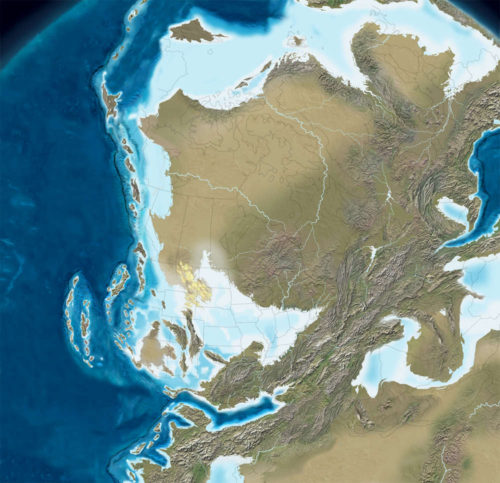
Paleogeographic reconstruction of the Earth at the time of the formation of the Chilliwack River Limestone, 300 million years ago. Note the faint superimposed map of the United States; the shoreline of the continental United States ends at Montana and Washington State has not yet been formed. Ron Blakey Colorado Plateau Geosystems Inc. For more information on Ron Blakey and his map-making process, and to look up a picture of the Earth during your favorite time period, please visit deeptimemaps.com
Come visit the rocks in the Sundew Collections to build your own story about how the Earth looked in the past! There are also other opportunities to explore natural history topics in our collections, such as plants, watersheds, fungi, etc! See you soon.

